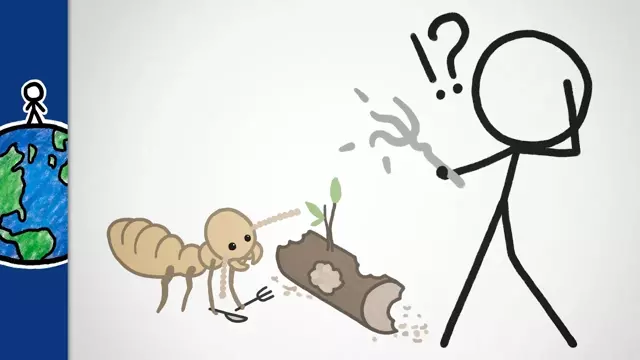2020-03-09
[public] 538K views, 18.7K likes, dislikes audio only
Thanks to OIST for sponsoring this video. To learn more, visit https://admissions.oist.jp/
Wood is abundant and full of energy, but outside of some insects, almost no animals eat it because the stuff it's made of is hard to break down.
If you liked this week’s video, you might also like:
Learn about the fungi that first unlocked the secrets of breaking down lignin: https://www.energy.gov/science/articles/behind-scenes-how-fungi-make-nutrients-available-world
LEARN MORE
**************
To learn more about this topic, start your googling with these keywords:
- Xylophagy: the eating of wood
- Lignin: a class of complex organic polymers that form key structural materials in the support tissues of vascular plants and help make wood rigid.
- Cellulose: a polysaccharide consisting of chains of glucose monomers, which is the main constituent of plant cell walls.
- Lignin oxidation: a depolymerization method to break bonds in lignin molecules such as ether or carbon–carbon bonds by applying an oxidant such as oxygen.
- Depolymerization: the process of breaking down a polymer, such as lignin, into simpler monomers
- Trichonympha agilis: a specialized protist that lives in the hindguts of many termite species that breaks down the cellulose in the wood they eat and may contribute to the lignin oxidation process.
CREDITS
*********
Writer, Director, and Narrator: Julián Gustavo Gómez
Video Illustrator: Ever Salazar
With Contributions From: Henry Reich, Alex Reich, Kate Yoshida, Peter Reich, David Goldenberg, Sarah Berman, Arcadi Garcia Rius
Music by: Nathaniel Schroeder
MinuteEarth is produced by Neptune Studios LLC
SUPPORT MINUTEEARTH
**************************
If you like what we do, you can help us!:
- Become our patron: https://patreon.com/MinuteEarth
- Our merch: http://dftba.com/minuteearth
- Our book: https://minuteearth.com/books
- Share this video with your friends and family
- Leave us a comment (we read them!)
OUR LINKS
************
Youtube | https://youtube.com/MinuteEarth
TikTok | https://tiktok.com/@minuteearth
Twitter | https://twitter.com/MinuteEarth
Instagram | https://instagram.com/minute_earth
Facebook | https://facebook.com/Minuteearth
Website | https://minuteearth.com
REFERENCES
**************
Bourguignon, Thomas, et al. "Rampant host switching shaped the termite gut microbiome." Current biology 28.4 (2018): 649-654.
Martin, Michael M. "Cellulose digestion in insects." Comparative Biochemistry and Physiology Part A: Physiology 75.3 (1983): 313-324.Mathews, Stephanie L., et al. "Public questions spur the discovery of new bacterial species associated with lignin bioconversion of industrial waste." Royal Society open science 6.3 (2019): 180748.
Chaney, William Reynolds. Why Do Animals Eat the Bark and Wood of Trees and Shrubs?. Purdue University Cooperative Extension Service, 2003.
de Gonzalo, Gonzalo, et al. "Bacterial enzymes involved in lignin degradation." Journal of Biotechnology 236 (2016): 110-119.
Hosokawa, Takahiro, et al. "Strict host-symbiont cospeciation and reductive genome evolution in insect gut bacteria." PLoS biology 4.10 (2006).
Novaes, Evandro, et al. "Lignin and biomass: a negative correlation for wood formation and lignin content in trees." Plant Physiology 154.2 (2010): 555-561.
Vega, Fernando E., and Richard W. Hofstetter, eds. Bark beetles: biology and ecology of native and invasive species. Academic Press, 2014.
McNab, Brian Keith. The physiological ecology of vertebrates: a view from energetics. Cornell University Press, 2002.
Bourguignon, Thomas, et al. "The evolutionary history of termites as inferred from 66 mitochondrial genomes." Molecular Biology and Evolution 32.2 (2014): 406-421.
Morgenstern, I., Klopman, S., & Hibbett, D. S. (2008). Molecular Evolution and Diversity of Lignin Degrading Heme Peroxidases in the Agaricomycetes. Journal of Molecular Evolution, 66(3), 243–257.
Suman, S. K., Dhawaria, M., Tripathi, D., Raturi, V., Adhikari, D. K., & Kanaujia, P. K. (2016). Investigation of lignin biodegradation by Trabulsiella sp. isolated from termite gut. International Biodeterioration & Biodegradation, 112, 12–17.
Janusz, G., Pawlik, A., Sulej, J., Świderska-Burek, U., Jarosz-Wilkołazka, A., & Paszczyński, A. (2017). Lignin degradation: microorganisms, enzymes involved, genomes analysis and evolution. FEMS Microbiology Reviews, 41(6), 941–962.
Ayuso-Fernández, Iván, Francisco J. Ruiz-Dueñas, and Angel T. Martínez. "Evolutionary convergence in lignin-degrading enzymes." Proceedings of the National Academy of Sciences 115.25 (2018): 6428-6433.
Ruiz-Dueñas, F. J., & Martínez, Á. T. (2009). Microbial degradation of lignin: how a bulky recalcitrant polymer is efficiently recycled in nature and how we can take advantage of this. Microbial Biotechnology, 2(2), 164–177.
Hibbing, Michael E., et al. "Bacterial competition: surviving and thriving in the microbial jungle." Nature Reviews Microbiology 8.1 (2010): 15-25.
https://patreon.com/minuteearth
/youtube/channel/UCeiYXex_fwgYDonaTcSIk6w
https://patreon.com/minuteearth
/youtube/video/4DF94Wvtekk

